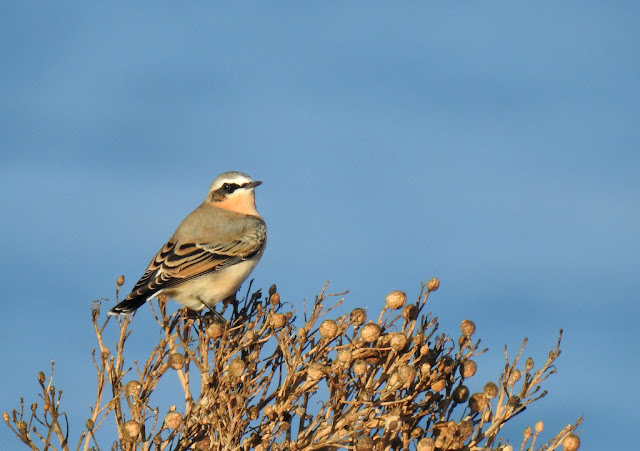I awoke at some ghastly hour this morning and peered into the garden to see if any big and exciting moths were clinging to the moth towel. It was pitch dark. Hmmm... Not a good sign really, considering there ought to have been at least the glow of a 40W actinic lamp brightening things up...
It appears that last night's rain had got where it shouldn't, and tripped the power supply. Which effectively did for the nocmig recorder too. So. No nocmig, and almost no moths. Thankfully the latest moth tick had appeared shortly after dark and was safely potted already. Blastobasis lacticolella is not as exciting as a Clifden Nonpareil, but beggars can't be choosers.
Still, every cloud...etc...
Yes, for once I made it to Cogden nice and early. Nothing dramatic, but 26 Chiffs, 19 Blackcaps, 16 Wheatears, 4 Willow Warblers, 2 Whinchats and 2 Goldcrests kept things lively. Bird of the morning was this...

|
|
Juv Grey Plover on the beach. I think it's the first I've seen at
Cogden this year. |
It didn't hang around long, heading away east just offshore...

|
|
Diagnostic black armpit on show. |
The only other species I bothered pointing the camera at could safely have been predicted by anyone who ever reads this blog...

|
| Wheatear |

|
| Wheatear |

|
| Wheatear |
Apparently Blastobasis lacticolella is native to Madeira, and was accidentally introduced to Britain around 1946. There are lots of Dorset dots on Living Record, but mostly in the east of the county. With just a couple of Bridport records on the map, perhaps this is a fairly decent local catch...
The moth trap invariably attracts lots of non-moths, and occasionally I am sufficiently intrigued to reach for a pot. Various beetles and shieldbugs have tempted me, but the other night I spotted this thing on the cabin wall...

|
|
Cricket sp. |
A fairly small and spindly-looking cricket, and a hand lens revealed that it lacked speckles, so definitely not Speckled Bush Cricket. A quick bit of detective work soon confirmed its identity as Southern Oak Bush Cricket, a new one on me. Apparently a recent colonist from Southern Europe, it was first recorded from Surrey and Berkshire in 2001, since when it has spread widely. Ours appears to be the furthest west in Dorset, according to the NBN Atlas, but Devon recorded its first in 2016, so it has sneaked past us already. Even so, what a great record for the garden!

|
|
Southern Oak Bush Cricket. The species has only vestigial wings,
so it definitely didn't fly to Britain from the Continent! |
All this recent moth and insect stuff has stirred happy memories of long ago. When our boys were young we sometimes took them to the Amateur Entomological Society's annual exhibition at Kempton Park Race Course. It must be pushing 25 years since our last visit, but the first exhibition since pre-Covid days is coming up fast. So I thought, 'Why not?'
And a trip is on...

Hi Gav, Id be surprised if you dont find that lacticollella isnt more common than records suggest. Ive taken it on 181 dates since I started trapping here with up to 4 in a night. Id expect that your location would do much better than that... as for 'London Dowd'! Pfff cheeky tw.....
ReplyDeleteCheers Stew. It certainly appears regular further east, and I can't imagine why so few local records. There are certainly one or two very expert moth-ers in the Bridport area, so I can only surmise that it's seeming scarcity here is genuine. As for the vernacular name, well... 😄
Delete